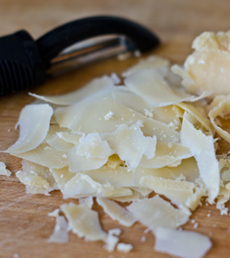TIP OF THE DAY: Shave Parmesan Onto Everything
|
You shave Parmesan cheese onto pasta and risotto, meatballs and Caesar salad; maybe on other green salads, too; perhaps to garnish soups. But why stop there?
Armed with two different grating gadgets*, the space for which we need to justify, we’ve been shaving Parmesan cheese onto just about everything. Just a bit goes a long way as a tangy, nutty garnish. We add shaved Parmesan cheese to these dishes (if cooked, after they come off the heat): |
 Sliced steak and salad with shaved Parmesan. Photo courtesy Blissfully Delicious. Here’s the recipe. |
|
|
|
||
 You can shave Parmesan with a vegetable peeler. Photo courtesy Once Upon A Chef. |
PARMESAN & PARMIGIANO-REGGIANO: THE DIFFERENCE “Parmesan cheese” can be produced anywhere on earth, however the manufacturer desires. Parmigiano-Reggiano dates to medieval Italy. It is PDO-protected and produced only by members of a consortium, the Consorzio del formaggio Parmigiano Reggiano. It can only be made from the milk of local cows in the Italian provinces of Parma, Reggio Emilia, Modena and certain parts of Bologna and Mantova. Producers must adhere to strict Consorzio guidelines, which ensure that the cheeses develop the profoundly complex flavors of authentic Parmigiano-Reggiano. Wheels that don’t meet the standards are declassified and aren’t given the official Consorzio stamp. Note to connoisseurs: The best Parmigiano-Reggiano cheese is considered to be Vacche Rosse (“Red Cow”), with milk from a specific herd of cows, that is 30 months. If you can’t find it locally, you can buy it at iGourmet.com. |
|
|
For most people, generic Parmesan is just fine. For connoisseurs, tasting the real deal can be an eye-opener. It is intense and complex, with nutty, sweet, grassy, creamy and fruity flavors. That’s why it has long been called called the “King of Cheeses.” |
||


